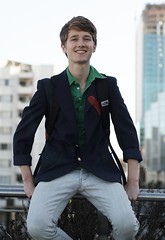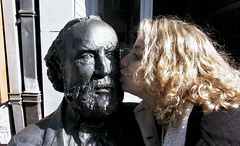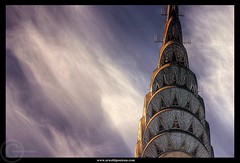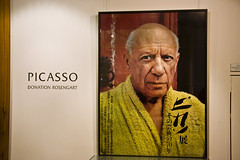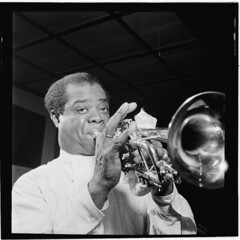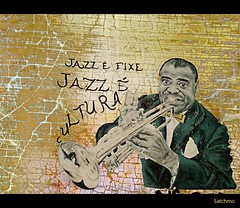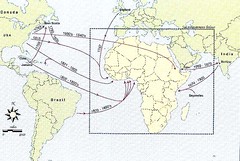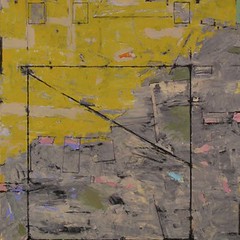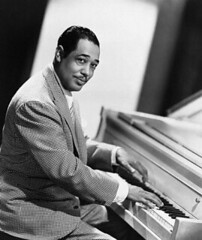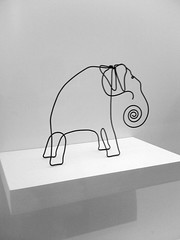Style show: a project for 2nd semester:
- a multi-media dress-up show.
- each Fine Arts student would be a model in this show.
- find a style that includes a blazer or vest or sweater and that reflects casual elegance.
- your appearance will be accompanied by a projected presentation.
- include images of variations on the look you have chosen.
- include remarks from your
* mother
* father
* style-conscious classmate
- include brief musical background.
- include a reference that connects your style to classical apparel.
- show will be presented to classmates in arts-related classes.
A reference story from the New York Times.
Style show will be preceded by a unit on the history of apparel. Eras upon which we will peer:
Greek
Roman
Chinese
Medieval
Renaissance
Reformation
Industrial Revolution
turn-of-the-century
Roaring Twenties
WWII
Fifties
Late 60's
80's
Friday, December 18, 2009
Mozart and Bach: describing the differences between the 2 giants of classical music
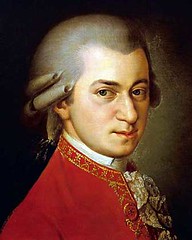
Johannes Chrysostomus Wolfgangus Theophilus Mozart (January 27th, 1756 - December 5th, 1791)
Originally uploaded by violinsoldier
You will hear the music of these two composers in every phase of your life. My goal is to enable you to have a clear and concise way of distinguishing between them.
- Include the titles of their well-known tunes, aka their works or pieces.
- Use no less than 10 images. Edit the biographical material so that each image has about 4 brief items.
- Document. List all the sites that provide your material.
- Think in terms of presenting this project to a Magnet history class.
Thursday, December 17, 2009
Saxophones would be hellaciously long if they weren't curved
The saxophone is a conical-bored transposing musical instrument considered a member of the woodwind family, says Wikipedia.
Saxophones are usually made of brass and are played with a single-reed mouthpiece similar to that of the clarinet. The saxophone was invented by Adolphe Sax in 1841.
He wanted to create an instrument that would both be the loudest of the woodwinds and the most versatile of the brass, and would fill the then vacant middle ground between the two sections.
The simplest design of saxophone is a straight conical tube, and the sopranino and soprano saxophones are usually of this straight design. However, as the lower-pitched instruments would be unacceptably long if straight, for ergonomic reasons the larger instruments usually incorporate a U-bend at or slightly above the third-lowest tone hole. As this would cause the bell of the instrument to point almost directly upwards, the end of the instrument is either beveled or tilted slightly forwards. This U-shape has become an iconic feature of the saxophone family, to the extent that soprano and even sopranino saxes are sometimes made in the curved style even though this is not strictly necessary.
Saxophones are usually made of brass and are played with a single-reed mouthpiece similar to that of the clarinet. The saxophone was invented by Adolphe Sax in 1841.
He wanted to create an instrument that would both be the loudest of the woodwinds and the most versatile of the brass, and would fill the then vacant middle ground between the two sections.
The simplest design of saxophone is a straight conical tube, and the sopranino and soprano saxophones are usually of this straight design. However, as the lower-pitched instruments would be unacceptably long if straight, for ergonomic reasons the larger instruments usually incorporate a U-bend at or slightly above the third-lowest tone hole. As this would cause the bell of the instrument to point almost directly upwards, the end of the instrument is either beveled or tilted slightly forwards. This U-shape has become an iconic feature of the saxophone family, to the extent that soprano and even sopranino saxes are sometimes made in the curved style even though this is not strictly necessary.
Jazz would not be quite that same without the work of Adolphe Sax in the 1800's
Antoine-Joseph "Adolphe" Sax (November 6, 1814 – February 4, 1894[1]) was a Belgian musical instrument designer and musician who played the flute and clarinet, and is best known for inventing the saxophone, says Wikipedia.
He patented the saxophone in 1846.
Composer Hector Berlioz wrote approvingly of the new instrument in 1842.
By 1846 Sax had designed, on paper, a full range of saxophones (from sopranino to subcontrabass). Although they never became standard orchestral instruments, the saxophones made his reputation, and secured him a job teaching at the Paris Conservatoire from 1867.
He patented the saxophone in 1846.
Composer Hector Berlioz wrote approvingly of the new instrument in 1842.
By 1846 Sax had designed, on paper, a full range of saxophones (from sopranino to subcontrabass). Although they never became standard orchestral instruments, the saxophones made his reputation, and secured him a job teaching at the Paris Conservatoire from 1867.
John Coltrane, one of the most powerful and influential jazz saxophonists
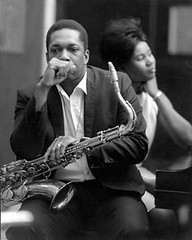
John Coltrane and Alice Coltrane during the 1960s. The couple made monumental contributions in the field of music and social consciousness.
Originally uploaded by Pan-African News Wire File Photos
Working in the bebop and hard bop idioms early in his career, Coltrane helped pioneer the use of modes in jazz and later was at the forefront of free jazz.
He was prolific, making about fifty recordings as a leader during his recording career, and appeared as a sideman on many other albums, notably with trumpeter Miles Davis and pianist Thelonious Monk. As his career progressed, Coltrane's music took on an increasingly spiritual dimension. His second wife was pianist Alice Coltrane, and their son Ravi Coltrane is also a saxophonist.
He influenced innumerable musicians, and remains one of the most significant tenor saxophonists in jazz history.
As a teen he left his home in High Point, NC, and moved to Philadelphia. He studied music; he enlisted in the Navy.
In 1945 he saw Charlie Parker perform for the first time. In a DownBeat article in 1960 he recalled: "the first time I heard Bird play, it hit me right between the eyes.
Miles Davis found him and invited him to join his quintet. In 1956 they did the albums issued as Cookin', Relaxin', Workin', and Steamin', some of the most treasured titles in Davis's early discography. The group disbanded in mid April due partly to Coltrane's problematic heroin addiction.[1]
During the later part of 1957 Coltrane worked with Thelonious Monk at New York’s Five Spot, a legendary jazz club, and played in Monk's quartet. The resulting album, Thelonious Monk Quartet with John Coltrane at Carnegie Hall, has been widely acclaimed.
Coltrane rejoined Davis in January 1958. In October 1958, jazz critic Ira Gitler coined the term "sheets of sound" to describe the style Coltrane developed during his stint with Monk and was perfecting in Miles' group, now a sextet. His playing was compressed, with rapid runs cascading in hundreds of notes per minute. During this time he performed on Kind of Blue, and the live recordings Miles & Monk at Newport and Jazz at the Plaza.[1]
Coltrane recorded his first album comprising his own compositions exclusively, Giant Steps. The title track is generally considered to have the most complex and difficult chord progression of any widely-played jazz composition.
With Atlantic Records, for whom he had recorded Giant Steps, his first record with a new group was also his debut playing the soprano saxophone; the album was the hugely successful My Favorite Things.
In the early 1960's he recorded for Impulse Records and expanded his experimental style. Critics were fiercely divided in their estimation of Coltrane. Audiences, too, were perplexed; in France he was famously booed during his final tour with Davis. In 1961, Down Beat magazine indicted Coltrane, along with Eric Dolphy, as players of "Anti-Jazz" in an article that bewildered and upset the musicians.
He responded by making albums which were more conservative and accessible. He recorded an album of ballads and participated in collaborations with Duke Ellington on the album Duke Ellington and John Coltrane and with deep-voiced ballad singer Johnny Hartman on an eponymous co-credited album.
His quartet produced their most famous record, A Love Supreme, in December 1964. A culmination of much of Coltrane's work up to this point, this four-part suite is an ode to his faith in and love for God. These spiritual concerns would characterize much of Coltrane's composing and playing from this point onwards, as can be seen from album titles such as Ascension, Om and Meditations.
Recordings in the first half of 1965 show Coltrane's playing becoming increasingly abstract, with greater incorporation of devices like multiphonics, utilization of overtones, and playing in the altissimo register, as well as a return to Coltrane's sheets of sound. In the studio, he abandoned his soprano to concentrate on the tenor saxophone. In addition, the quartet responded to the leader by playing with increasing freedom.
In 1965 Coltrane may have begun using LSD[8][9] - informing the sublime, "cosmic" transcendence of his late period, and also its incomprehensibility to many listeners. Drummer Philly Joe Jones's and pianist McCoy Tyner's departed. Coltrane and saxophonist Pharaoh Sanders were described by Nat Hentoff as "speaking in tongues". When touring, the group was known for playing very lengthy versions of their repertoire, many stretching beyond 30 minutes and sometimes even being an hour long. Concert solos for band members regularly extended beyond fifteen minutes in duration.
Coltrane died from liver cancer at Huntington Hospital on Long Island in 1967, at the age of 40. Biographer Lewis Porter has suggested, somewhat controversially, that the cause of Coltrane's illness was hepatitis, although he also attributed the disease to Coltrane's heroin use.[10]
Tuesday, December 15, 2009
History of jazz presentation using Miles Davis and one additional figure
With a partner, please develop a 10-image history of jazz presentation in Google Docs.
* Using 3 bulleted items per image, compare the fine arts impact of Miles Davis to another 20th century musical artist. Each student will use 4 images in developing the biography and one image on comparison.
* Document each slide in fine type at the lower edge.
* Due at the end of the hour. 3 pts.
* Though the project must be filed in your GoogleDocs, please do Not send notification to trudeau11.
20th century cats -
- Duke Ellington
- John Coltrane
- Igor Stravinsky
- Aaron Copeland
- Billie Holiday
- Ella Fitzgerald
- Nat King Cole
- Jellyroll Morton
- Joe King Oliver
- Wynton Marsalis
- Leonard Bernstein
- Thelonius Monk
- Charlie Parker
For concise biographies, please see the Ken Burns Jazz site.
* Using 3 bulleted items per image, compare the fine arts impact of Miles Davis to another 20th century musical artist. Each student will use 4 images in developing the biography and one image on comparison.
* Document each slide in fine type at the lower edge.
* Due at the end of the hour. 3 pts.
* Though the project must be filed in your GoogleDocs, please do Not send notification to trudeau11.
20th century cats -
- Duke Ellington
- John Coltrane
- Igor Stravinsky
- Aaron Copeland
- Billie Holiday
- Ella Fitzgerald
- Nat King Cole
- Jellyroll Morton
- Joe King Oliver
- Wynton Marsalis
- Leonard Bernstein
- Thelonius Monk
- Charlie Parker
For concise biographies, please see the Ken Burns Jazz site.
Saturday, December 12, 2009
A tour of Manhattan multiple choice test
Choose the best location description - in Manhattan, unless otherwise noted. Please send & save your answers via GoogleDocs.
1. Harlem: a) Above Central Park b) South of Theater District c) Midtown d) Upper West Side.
2. Columbia U.: a) Upper West Side b) Upper East Side c) Midtown d) Harlem.
3. Fifth Ave.: a) Upper West Side b) Upper East Side c) Midtown d) Lower East Side.
4. The Dakota (apt bldg): a) Upper West Side b) Upper East Side c) Midtown d) Harlem.
5. Metropolitan Museum of Art: a) Central Park b) Greenwich Village c) Financial District.
6. Guggenheim Museum: a) Central Park b) Greenwich Village c) Financial District d) SoHo.
7. Plaza Hotel: a) Central Park b) Theater District c) Tribeca d) Upper West Side.
8. Lincoln Center: a) Upper West Side b) Upper East Side c) Midtown d) Harlem.
9. Metropolitan Opera House: a) a) Central Park b) Greenwich Village c) Financial District d) Upper West Side.
10. Rockefeller Center: a) Upper West Side b) Upper East Side c) Midtown d) SoHo.
11. UN Headquarters: a) Hudson R b) East R c) Harlem R d) Long Island Sound.
12. Broadway: a) North-South b) East-West c) Bronx-Manhattan-Brooklyn.
13. Carnegie Hall: a) Upper West Side b) Upper East Side c) Midtown d) SoHo.
14. MoMA / Museum of Modern Art: a) Upper West Side b) Upper East Side c) Midtown d) Lower East Side.
15. Empire State Bldg. is at 34th St and a) Fifth Ave b) Broadway c) 42nd St.
16. Washington Square Park: a) Central Park b) Greenwich Village c) Financial District d) Upper West Side.
17. NYU: a) Central Park b) Greenwich Village c) Financial District d) Upper West Side.
18. Greenwich Village: a) Upper West Side b) Upper East Side c) Above Midtown d) Above SoHo.
19. Chrysler Bldg: a) Upper West Side b) Upper East Side c) Midtown d) Lower East Side.
20. Lower East Side: a) Brooklyn Bridge b) George Washington Bridge c) Lincoln Tunnel d) Staten Is Ferry.
21. Little Italy & Chinatown: a) Upper West Side b) Upper East Side c) Midtown d) Lower East Side.
22. Wall St / Financial District: a) New Amsterdam b) Greenwich Village c) Harlem
d) Upper East Side.
23. NYSE is closer to a) 1st St b) 34th St c) 42nd St d) 155th St
24. Former World Trade Center site closer to: a) Wall St. b) 42nd St c) Brooklyn Bridge d) Fifth Ave.
25. Battery Park: a) Upper West Side b) Upper East Side c) Midtown d) Financial District.
26. New Amsterdam: a) Upper West Side b) Upper East Side c) Midtown d) Financial District.
27. 42nd St: a) Garment District b) Financial District c) Theater District d) Spanish Harlem.
28. Lenox Ave / Malcolm X Blvd: a) Upper West Side b) Upper East Side c) Midtown d) Harlem.
1. Harlem: a) Above Central Park b) South of Theater District c) Midtown d) Upper West Side.
2. Columbia U.: a) Upper West Side b) Upper East Side c) Midtown d) Harlem.
3. Fifth Ave.: a) Upper West Side b) Upper East Side c) Midtown d) Lower East Side.
4. The Dakota (apt bldg): a) Upper West Side b) Upper East Side c) Midtown d) Harlem.
5. Metropolitan Museum of Art: a) Central Park b) Greenwich Village c) Financial District.
6. Guggenheim Museum: a) Central Park b) Greenwich Village c) Financial District d) SoHo.
7. Plaza Hotel: a) Central Park b) Theater District c) Tribeca d) Upper West Side.
8. Lincoln Center: a) Upper West Side b) Upper East Side c) Midtown d) Harlem.
9. Metropolitan Opera House: a) a) Central Park b) Greenwich Village c) Financial District d) Upper West Side.
10. Rockefeller Center: a) Upper West Side b) Upper East Side c) Midtown d) SoHo.
11. UN Headquarters: a) Hudson R b) East R c) Harlem R d) Long Island Sound.
12. Broadway: a) North-South b) East-West c) Bronx-Manhattan-Brooklyn.
13. Carnegie Hall: a) Upper West Side b) Upper East Side c) Midtown d) SoHo.
14. MoMA / Museum of Modern Art: a) Upper West Side b) Upper East Side c) Midtown d) Lower East Side.
15. Empire State Bldg. is at 34th St and a) Fifth Ave b) Broadway c) 42nd St.
16. Washington Square Park: a) Central Park b) Greenwich Village c) Financial District d) Upper West Side.
17. NYU: a) Central Park b) Greenwich Village c) Financial District d) Upper West Side.
18. Greenwich Village: a) Upper West Side b) Upper East Side c) Above Midtown d) Above SoHo.
19. Chrysler Bldg: a) Upper West Side b) Upper East Side c) Midtown d) Lower East Side.
20. Lower East Side: a) Brooklyn Bridge b) George Washington Bridge c) Lincoln Tunnel d) Staten Is Ferry.
21. Little Italy & Chinatown: a) Upper West Side b) Upper East Side c) Midtown d) Lower East Side.
22. Wall St / Financial District: a) New Amsterdam b) Greenwich Village c) Harlem
d) Upper East Side.
23. NYSE is closer to a) 1st St b) 34th St c) 42nd St d) 155th St
24. Former World Trade Center site closer to: a) Wall St. b) 42nd St c) Brooklyn Bridge d) Fifth Ave.
25. Battery Park: a) Upper West Side b) Upper East Side c) Midtown d) Financial District.
26. New Amsterdam: a) Upper West Side b) Upper East Side c) Midtown d) Financial District.
27. 42nd St: a) Garment District b) Financial District c) Theater District d) Spanish Harlem.
28. Lenox Ave / Malcolm X Blvd: a) Upper West Side b) Upper East Side c) Midtown d) Harlem.
Thursday, December 10, 2009
Picasso: interactive biography
How to visit New York City on a tight budget
For those of us who live here, the expense of New York City is something we’ve long since adjusted to, says NY Times writer Matt Gross.
Designer tank tops for $140, truffled hamburgers for $150, studio apartments renting for upward of $3,000 — even in the midst of recession, these things seem somehow normal, the price of admission to the greatest city in the world.
For visitors, however, these can be seriously intimidating numbers. Even if you’re not aiming for high-end Manhattan indulgence, the basic costs of lodging, transportation, food, shopping and entertainment are the most expensive in the nation.
But there’s an easy way to bring the price of a New York vacation down to earth. It’s called research.
About six months ago, I put together a frugal traveler’s guide to trip planning, which involved lots of Googling and various Web sites like Craigslist and Oanda.com. Now I’ve created one specifically for New York City, offering what I hope is everything you’ll need to figure out how to have a good time without a Wall Street bonus.
Designer tank tops for $140, truffled hamburgers for $150, studio apartments renting for upward of $3,000 — even in the midst of recession, these things seem somehow normal, the price of admission to the greatest city in the world.
For visitors, however, these can be seriously intimidating numbers. Even if you’re not aiming for high-end Manhattan indulgence, the basic costs of lodging, transportation, food, shopping and entertainment are the most expensive in the nation.
But there’s an easy way to bring the price of a New York vacation down to earth. It’s called research.
About six months ago, I put together a frugal traveler’s guide to trip planning, which involved lots of Googling and various Web sites like Craigslist and Oanda.com. Now I’ve created one specifically for New York City, offering what I hope is everything you’ll need to figure out how to have a good time without a Wall Street bonus.
Wednesday, December 9, 2009
Louis Armstrong and the Giants of Jazz
Jazz & Vocab quiz and answers
Sony window
Originally uploaded by trudeau
1. Ellington Great pianist as well as band leader and composer?
2. Ellington Famous as a New Yorker but was a native of Washington, DC?
3. Armstrong Loved smoking reefer?
4. Armstrong Cut some great records in Chicago?
5. Ellington Famous for the tune "Take the A Train"?
6. Armstrong Famous for his performances of the tune "Basin St Blues"?
7. Reinhardt Played his instrument with 2 fingers?
8. Armstrong Married 4 times?
9. Reinhardt Born and raised in Belgium?
10. Armstrong Wrote 2 biographies?
Vocab - sociocultural, hermeneutic, enigmatic, abysmal, cacophony, solace, quantum, squalling, disharmonious, dramatic foil, pouty, semi-coherent, brooding, mopey, ciphers, flouting, libido, rakish, facade, somber, demeanor, suave, cynical, cold war, totalitarian, humorlessness, paladin, pseudoserious,, cosmopolitan, provincial
11. sonically chaotic: cacaphony or disharmonious
12. showing off - bragging: flouting
13. the face of a buidling or a person: facade
14. mysterious: enigmatic
15. rotten terrible: abysmal
16. soberly controls your entire life: totalitarian
17. person with broad educational background and broad point of view: cosmopolitan
18. the psychic and emotional energy associated with instinctual biological drives: libido
19. a paragon of chivalry; a heroic champion: paladin
20. person whose education and outlook are limited and inhibited: provincial, parochial
Back to jazz -
21. Chicago Second city of Jazz (and of the US in general): __ .
22. NYC City in which the fathers of jazz - such as Joe Oliver and Louis Armstrong settled.
23. diaspora Movement of impoverished black Americans from the farms of the Deep South to urban centers of Upper Midwest and Northeast: __ .
24. 1890's - 1900 Approximate date for the birth of jazz: __ .
25. Congo Square or Place Congo Name given to the place in New Orleans where slaves gathered on Sundays: __ __ .
26. Creole Louisiana term for people of mixed ethnic background, esp. a mixture of French, Spanish, native American and Afro-Caribbean: __ .
27. African (or mixed) Gens de couleur libre was a special ethnic category in NO. It indicated a person who was __ yet not a slave.
28. Second line Parade dance practiced by New Orleanians in funeral processions: __ __ .
29. Dizzy Gillespie A radical bend in the direction of his trumpet’s bell became part of the visual signature of __ __.
30. shibboleth "Break it down," "chops," "crib," "daddy-o," "dig" and similar words were jazz __, words that could indicate that you were an insider. Eventually these words went mainstream, such as the recent phrase “wanna give a shout-out to Shirley.”
Sony window
Originally uploaded by trudeau
1. Ellington Great pianist as well as band leader and composer?
2. Ellington Famous as a New Yorker but was a native of Washington, DC?
3. Armstrong Loved smoking reefer?
4. Armstrong Cut some great records in Chicago?
5. Ellington Famous for the tune "Take the A Train"?
6. Armstrong Famous for his performances of the tune "Basin St Blues"?
7. Reinhardt Played his instrument with 2 fingers?
8. Armstrong Married 4 times?
9. Reinhardt Born and raised in Belgium?
10. Armstrong Wrote 2 biographies?
Vocab - sociocultural, hermeneutic, enigmatic, abysmal, cacophony, solace, quantum, squalling, disharmonious, dramatic foil, pouty, semi-coherent, brooding, mopey, ciphers, flouting, libido, rakish, facade, somber, demeanor, suave, cynical, cold war, totalitarian, humorlessness, paladin, pseudoserious,, cosmopolitan, provincial
11. sonically chaotic: cacaphony or disharmonious
12. showing off - bragging: flouting
13. the face of a buidling or a person: facade
14. mysterious: enigmatic
15. rotten terrible: abysmal
16. soberly controls your entire life: totalitarian
17. person with broad educational background and broad point of view: cosmopolitan
18. the psychic and emotional energy associated with instinctual biological drives: libido
19. a paragon of chivalry; a heroic champion: paladin
20. person whose education and outlook are limited and inhibited: provincial, parochial
Back to jazz -
21. Chicago Second city of Jazz (and of the US in general): __ .
22. NYC City in which the fathers of jazz - such as Joe Oliver and Louis Armstrong settled.
23. diaspora Movement of impoverished black Americans from the farms of the Deep South to urban centers of Upper Midwest and Northeast: __ .
24. 1890's - 1900 Approximate date for the birth of jazz: __ .
25. Congo Square or Place Congo Name given to the place in New Orleans where slaves gathered on Sundays: __ __ .
26. Creole Louisiana term for people of mixed ethnic background, esp. a mixture of French, Spanish, native American and Afro-Caribbean: __ .
27. African (or mixed) Gens de couleur libre was a special ethnic category in NO. It indicated a person who was __ yet not a slave.
28. Second line Parade dance practiced by New Orleanians in funeral processions: __ __ .
29. Dizzy Gillespie A radical bend in the direction of his trumpet’s bell became part of the visual signature of __ __.
30. shibboleth "Break it down," "chops," "crib," "daddy-o," "dig" and similar words were jazz __, words that could indicate that you were an insider. Eventually these words went mainstream, such as the recent phrase “wanna give a shout-out to Shirley.”
Satchmo, an introduction and overview
Let's say that jazz begins with an angelic entertainer from New Orleans named Louis Satchmo Armstrong.
Louis Armstrong (4 August 1901– July 6, 1971), nicknamed Satchmo, ("Satchel mouth") was an American jazz trumpeter and singer.
Coming to prominence in the 20s as an innovative cornet and trumpet virtuoso, Armstrong was a foundational influence on jazz, shifting the music's focus from collective improvisation to solo performers.
With his distinctive gravelly voice, Armstrong was an influential singer, demonstrating great dexterity as an improviser, bending the lyrics and melody of a song for expressive purposes. He was also greatly skilled at scat singing, or wordless vocalizing.
Renowned for his charismatic stage presence, Armstrong's influence extended well beyond jazz, and by the end of his career in the '60s, he was widely regarded as a profound influence on popular music in general, and perhaps the most important American musician of the 20th century.
Armstrong died of a heart attack on July 6, 1971, at age 69, 11 months after playing a famous show at the Waldorf-Astoria's Empire Room. Shortly before his death he stated, "I think I had a beautiful life. I didn't wish for anything that I couldn't get and I got pretty near everything I wanted because I worked for it."
His residence was Corona, Queens, New York City. Today his house has become a museum for jazz history.
Louis Armstrong (4 August 1901– July 6, 1971), nicknamed Satchmo, ("Satchel mouth") was an American jazz trumpeter and singer.
Coming to prominence in the 20s as an innovative cornet and trumpet virtuoso, Armstrong was a foundational influence on jazz, shifting the music's focus from collective improvisation to solo performers.
With his distinctive gravelly voice, Armstrong was an influential singer, demonstrating great dexterity as an improviser, bending the lyrics and melody of a song for expressive purposes. He was also greatly skilled at scat singing, or wordless vocalizing.
Renowned for his charismatic stage presence, Armstrong's influence extended well beyond jazz, and by the end of his career in the '60s, he was widely regarded as a profound influence on popular music in general, and perhaps the most important American musician of the 20th century.
Armstrong died of a heart attack on July 6, 1971, at age 69, 11 months after playing a famous show at the Waldorf-Astoria's Empire Room. Shortly before his death he stated, "I think I had a beautiful life. I didn't wish for anything that I couldn't get and I got pretty near everything I wanted because I worked for it."
His residence was Corona, Queens, New York City. Today his house has become a museum for jazz history.
African Atlantic diaspora / African-American post-WWI diaspora
Blues & jazz develop along the trail of the Black American dispora
As Black Americans left the field hand work of Louisiana, Mississippi and other southern states, they took their culture and went north. In cities such as St Louis and Chicago they found factory work, housing in tenement buildings and a different - if not particularly better - life.
The story of Louis Armstrong and Joe King Oliver was to leave New Orleans and go to Chicago - where they were much in demand for performing and recording.
Eventually both pushed on to NYC, the Big Apple. It became the center of Jazz for decades.
The word diaspora (dispersal) also applies to the Jews (Palestine to Europe, etc), to Africans in the Atlantic slave trade and to the Irish, among others.
As Black Americans left the field hand work of Louisiana, Mississippi and other southern states, they took their culture and went north. In cities such as St Louis and Chicago they found factory work, housing in tenement buildings and a different - if not particularly better - life.
The story of Louis Armstrong and Joe King Oliver was to leave New Orleans and go to Chicago - where they were much in demand for performing and recording.
Eventually both pushed on to NYC, the Big Apple. It became the center of Jazz for decades.
The word diaspora (dispersal) also applies to the Jews (Palestine to Europe, etc), to Africans in the Atlantic slave trade and to the Irish, among others.
Monday, December 7, 2009
Birthplace of Jazz: the curious, Creole city of New Orleans

1904 :: Map of New Orleans Showing Street Railway System of the New Orleans Railways Co.
Originally uploaded by regional.modernism
From its early development until the present, jazz has incorporated music from 19th and 20th century American popular music.[1]
Its West African pedigree is evident in its use of blue notes, improvisation, polyrhythms, syncopation, and the swung note[2] but one of jazz's iconic figures Art Blakey has been quoted as saying, "No America, no jazz. I’ve seen people try to connect it to other countries, for instance to Africa, but it doesn’t have a damn thing to do with Africa".[3]
The word "jazz" began as a West Coast slang term of uncertain derivation and was first used to refer to music in Chicago in about 1915.
From its beginnings in the early 20th century, Jazz has spawned a variety of subgenres, from New Orleans Dixieland dating from the early 1910s, big band-style swing from the 1930s and 1940s, bebop from the mid-1940s, a variety of Latin jazz fusions such as Afro-Cuban and Brazilian jazz from the 1950s and 1960s, jazz-rock fusion from the 1970s and late 1980s developments such as acid jazz, which blended jazz influences into funk and hip-hop.
While jazz may be difficult to define, improvisation is clearly one of its key elements. Early blues was commonly structured around a repetitive call-and-response pattern, a common element in the African American oral tradition. A form of folk music which rose in part from work songs and field hollers of rural Blacks, early blues was also highly improvisational.
By 1808 the Atlantic slave trade had brought almost half a million Africans to the United States. The slaves largely came from West Africa and brought strong tribal musical traditions with them.[17] Lavish festivals featuring African dances to drums were organized on Sundays at Place Congo, or Congo Square, in New Orleans until 1843, as were similar gatherings in New England and New York. African music was largely functional, for work or ritual, and included work songs and field hollers.
In the early 19th century an increasing number of black musicians learned to play European instruments, particularly the violin, which they used to parody European dance music in their own cakewalk dances. In turn, European-American minstrel show performers in blackface popularized such music internationally, combining syncopation with European harmonic accompaniment.
The music of New Orleans had a profound effect on the creation of early jazz. Many early jazz performers played in the brothels and bars of the red-light district around Basin Street, called "Storyville."[25] In addition, numerous marching bands played at lavish funerals arranged by the African American community. The instruments used in marching bands and dance bands became the basic instruments of jazz: brass and reeds tuned in the European 12-tone scale and drums.
The cornetist Buddy Bolden is often mentioned as "the first man of jazz."
Map of New Orleans -
- Lake Pontchartrain
- Miss R
- Canal St
- Elysian Fields Ave
- Vieux Carre, French Quarter
- Jackson Square, St Louis Cathedral
- Cafe do Monde
- Antoine's Restaurant
- Place Congo, Louis Armstrong Park
- Central Business District (CBD)
- St Charles Ave
- Tulane U, Loyola U, Xavier U, Dillard U, SUNO, UNO
- Audubon Park & Zoo
Thursday, December 3, 2009
When Sandy met the Duke: describe a public art collaboration between Alxander Caldwell and Duke Ellington
It is Xmas, 1963. Rockefeller Center is to be the site of a month-long event that brings to the public a cultural gift that combines the talents of sculptor Alexander Calder and musician Duke Ellington.
Describe the event, briefly, emphasizing the achievements and strengths of the 2 artists.
Describe the event, briefly, emphasizing the achievements and strengths of the 2 artists.
Your listening portfolio . . .
Your teacher wants to have a profile of your music listening patterns.
Please help develop a profile of student listening by listing
a) favorite groups and categories:
ex: Kanye West, hip-hop/pop
b) where you get your music, typically:
c) How much you listen to
- jazz
- classical
- ethnic, electronic or other unusual musics
d) Your radio stations - and the music format of each.
Please help develop a profile of student listening by listing
a) favorite groups and categories:
ex: Kanye West, hip-hop/pop
b) where you get your music, typically:
c) How much you listen to
- jazz
- classical
- ethnic, electronic or other unusual musics
d) Your radio stations - and the music format of each.
Wednesday, December 2, 2009
Sophisticated jazz: American composer-pianist Duke Ellington
Edward Kennedy Ellington was born on April 29, 1899 to James Edward Ellington and Daisy Kennedy Ellington.
J.E. made blueprints for the United States Navy. He also worked as a butler for Dr. Middleton F. Cuthbert, a prominent white physician, and occasionally worked as a White House caterer.[9] Daisy and J.E. were both piano players—she played parlor songs and he operatic airs.
At the age of seven, Ellington began taking piano lessons from Marietta Clinkscales.[10] Daisy surrounded her son with dignified women to reinforce his manners and teach him to live elegantly.
Ellington’s childhood friends noticed that "his casual, offhand manner, his easy grace, and his dapper dress gave him the bearing of a young nobleman",[11] and began calling him Duke.
From 1917 through 1919, Ellington launched his musical career, painting commercial signs by day and playing piano by night. Ellington moved out of his parents' home and bought his own as he became a successful pianist.
Ellington played throughout the Washington, D.C. area and into Virginia for private society balls and embassy parties. The band thrived, performing for both African-American and white audiences, a rarity during the racially divided times.
In June 1923, a gig in Atlantic City, New Jersey led to a play date at the prestigious Exclusive Club in Harlem, followed in September 1923 by a move to the Hollywood Club, 49th and Broadway, and a four-year engagement, which gave Ellington a solid artistic base.
In 1925, Ellington contributed four songs to Chocolate Kiddies, an all-African-American revue which introduced European audiences to African-American styles and performers. "Duke Ellington and his Kentucky Club Orchestra" grew to a ten-piece organization, developing their distinct sound, displaying the non-traditional expression of Ellington’s arrangements, the street rhythms of Harlem, and the exotic-sounding trombone growls and wah-wahs, high-squealing trumpets, and sultry saxophone blues licks of the band members.
In 1927 Harlem's Cotton Club offered a weekly radio broadcast and famous white clientèle nightly pouring in to see the latest. Ellington and his band thrived in the period from 1932 to 1942, a "golden age" for the band.
In 1927 Ellington made a career-advancing agreement with agent-publisher Irving Mills giving Mills a 45% interest in Ellington's future.[20] Mills had an eye for new talent and early on published compositions by Hoagy Carmichael, Dorothy Fields, and Harold Arlen. During the 1930s, Ellington's popularity continued to increase, largely as a result of the promotional skills of Mills, who got more than his fair share of co-composer credits. Mills arranged recording sessions on the Brunswick, Victor, and Columbia labels which gave Ellington popular recognition. Mills took the management burden off of Ellington's shoulders, allowing him to focus on his band's sound and his compositions.
At the Cotton Club, Ellington's group performed all the music for the revues, which mixed comedy, dance numbers, vaudeville, burlesque, music, and illegal alcohol.
In 1929, Ellington appeared in his first movie, a nineteen-minute all-African-American RKO short, Black and Tan, in which he played the hero "Duke". In the same year, The Cotton Club Orchestra appeared on stage for several months in Florenz Ziegfeld's Show Girl, along with vaudeville stars Jimmy Durante, Eddie Foy, Jr., Al Jolson, Ruby Keeler, and with music and lyrics by George Gershwin and Gus Kahn.
As the Depression worsened, the recording industry was in crisis, dropping over 90% of its artists by 1933.[22] Ellington and his orchestra survived the hard times by taking to the road in a series of tours. Radio exposure also helped maintain popularity. Ivie Anderson was hired as their featured vocalist.
Ellington led the orchestra by conducting from the keyboard using piano cues and visual gestures; very rarely did he conduct using a baton. As a bandleader, Ellington was not a strict disciplinarian but he maintained control of his orchestra with a crafty combination of charm, humor, flattery, and astute psychology. A complex, private person, he revealed his feelings to only his closest intimates and effectively used his public persona to deflect attention away from himself.
While their United States audience remained mainly African-American in this period, the Cotton Club had a near exclusive white clientèle and the band had a huge following overseas, demonstrated both in a trip to England in 1933 and a 1934 visit to the European mainland.
On their tour through the segregated South in 1934, they avoided some of the traveling difficulties of African-Americans by touring in private railcars, which provided easy accommodations, dining, and storage for equipment, while avoiding the indignities of segregated facilities.
Ellington delivered some huge hits during the 1930s, which greatly helped to build his overall reputation. Some of them include: "Mood Indigo" (1930), "It Don't Mean a Thing (If It Ain't Got That Swing)" (1932), "Sophisticated Lady" (1933), "Solitude" (1934), "In a Sentimental Mood" (1935), "Caravan" (1937), "I Let A Song Go Out Of My Heart" (1938). "Take the "A" Train" which hit big in 1941, was written by Billy Strayhorn.
The band reached a creative peak in the early 1940s, when Ellington wrote for an orchestra of distinctive voices and displayed tremendous creativity.
Meanwhile, the development of modern jazz, or bebop, the music industry's shift to solo vocalists such as the young Frank Sinatra as the Big Band era receded. Bebop rebelled against commercial jazz, dancing to jazz, and strict forms to become the music of jazz aficionados. Furthermore, by 1950 the emerging African-American popular music style known as Rhythm and Blues drew away the young African-American audience and Rock & Roll soon followed. In the face of these major social shifts, Ellington continued on his own course.
J.E. made blueprints for the United States Navy. He also worked as a butler for Dr. Middleton F. Cuthbert, a prominent white physician, and occasionally worked as a White House caterer.[9] Daisy and J.E. were both piano players—she played parlor songs and he operatic airs.
At the age of seven, Ellington began taking piano lessons from Marietta Clinkscales.[10] Daisy surrounded her son with dignified women to reinforce his manners and teach him to live elegantly.
Ellington’s childhood friends noticed that "his casual, offhand manner, his easy grace, and his dapper dress gave him the bearing of a young nobleman",[11] and began calling him Duke.
From 1917 through 1919, Ellington launched his musical career, painting commercial signs by day and playing piano by night. Ellington moved out of his parents' home and bought his own as he became a successful pianist.
Ellington played throughout the Washington, D.C. area and into Virginia for private society balls and embassy parties. The band thrived, performing for both African-American and white audiences, a rarity during the racially divided times.
In June 1923, a gig in Atlantic City, New Jersey led to a play date at the prestigious Exclusive Club in Harlem, followed in September 1923 by a move to the Hollywood Club, 49th and Broadway, and a four-year engagement, which gave Ellington a solid artistic base.
In 1925, Ellington contributed four songs to Chocolate Kiddies, an all-African-American revue which introduced European audiences to African-American styles and performers. "Duke Ellington and his Kentucky Club Orchestra" grew to a ten-piece organization, developing their distinct sound, displaying the non-traditional expression of Ellington’s arrangements, the street rhythms of Harlem, and the exotic-sounding trombone growls and wah-wahs, high-squealing trumpets, and sultry saxophone blues licks of the band members.
In 1927 Harlem's Cotton Club offered a weekly radio broadcast and famous white clientèle nightly pouring in to see the latest. Ellington and his band thrived in the period from 1932 to 1942, a "golden age" for the band.
In 1927 Ellington made a career-advancing agreement with agent-publisher Irving Mills giving Mills a 45% interest in Ellington's future.[20] Mills had an eye for new talent and early on published compositions by Hoagy Carmichael, Dorothy Fields, and Harold Arlen. During the 1930s, Ellington's popularity continued to increase, largely as a result of the promotional skills of Mills, who got more than his fair share of co-composer credits. Mills arranged recording sessions on the Brunswick, Victor, and Columbia labels which gave Ellington popular recognition. Mills took the management burden off of Ellington's shoulders, allowing him to focus on his band's sound and his compositions.
At the Cotton Club, Ellington's group performed all the music for the revues, which mixed comedy, dance numbers, vaudeville, burlesque, music, and illegal alcohol.
In 1929, Ellington appeared in his first movie, a nineteen-minute all-African-American RKO short, Black and Tan, in which he played the hero "Duke". In the same year, The Cotton Club Orchestra appeared on stage for several months in Florenz Ziegfeld's Show Girl, along with vaudeville stars Jimmy Durante, Eddie Foy, Jr., Al Jolson, Ruby Keeler, and with music and lyrics by George Gershwin and Gus Kahn.
As the Depression worsened, the recording industry was in crisis, dropping over 90% of its artists by 1933.[22] Ellington and his orchestra survived the hard times by taking to the road in a series of tours. Radio exposure also helped maintain popularity. Ivie Anderson was hired as their featured vocalist.
Ellington led the orchestra by conducting from the keyboard using piano cues and visual gestures; very rarely did he conduct using a baton. As a bandleader, Ellington was not a strict disciplinarian but he maintained control of his orchestra with a crafty combination of charm, humor, flattery, and astute psychology. A complex, private person, he revealed his feelings to only his closest intimates and effectively used his public persona to deflect attention away from himself.
While their United States audience remained mainly African-American in this period, the Cotton Club had a near exclusive white clientèle and the band had a huge following overseas, demonstrated both in a trip to England in 1933 and a 1934 visit to the European mainland.
On their tour through the segregated South in 1934, they avoided some of the traveling difficulties of African-Americans by touring in private railcars, which provided easy accommodations, dining, and storage for equipment, while avoiding the indignities of segregated facilities.
Ellington delivered some huge hits during the 1930s, which greatly helped to build his overall reputation. Some of them include: "Mood Indigo" (1930), "It Don't Mean a Thing (If It Ain't Got That Swing)" (1932), "Sophisticated Lady" (1933), "Solitude" (1934), "In a Sentimental Mood" (1935), "Caravan" (1937), "I Let A Song Go Out Of My Heart" (1938). "Take the "A" Train" which hit big in 1941, was written by Billy Strayhorn.
The band reached a creative peak in the early 1940s, when Ellington wrote for an orchestra of distinctive voices and displayed tremendous creativity.
Meanwhile, the development of modern jazz, or bebop, the music industry's shift to solo vocalists such as the young Frank Sinatra as the Big Band era receded. Bebop rebelled against commercial jazz, dancing to jazz, and strict forms to become the music of jazz aficionados. Furthermore, by 1950 the emerging African-American popular music style known as Rhythm and Blues drew away the young African-American audience and Rock & Roll soon followed. In the face of these major social shifts, Ellington continued on his own course.
Tuesday, December 1, 2009
Alexander Calder : Paris 1926-1933 à Pompidou
The man credited with establishing the kinetic art form known as the mobile was, in the 1920's, an American in Paris: he was the engineer-turned-sculptor Alexander Calder. Please see an earlier Fine Arts post.
Cirque du Calder was his name for his circus-inspired early creations. It was articulated (hinged) art.
His stabiles - opposite of mobiles - were usually gigantic and made of steel.
reticulated: net-like; such as a Greek key design in a frieze.
Cirque du Calder was his name for his circus-inspired early creations. It was articulated (hinged) art.
His stabiles - opposite of mobiles - were usually gigantic and made of steel.
reticulated: net-like; such as a Greek key design in a frieze.
Subscribe to:
Posts (Atom)
